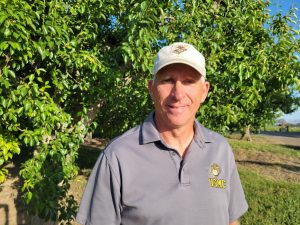Grower Interviews: Shawn Phelps

Zillah, WA
Pacific Northwest Pear Grower
When and where did you get started in the pear business?
After serving in the Marine Corp, I came back to Washington’s Yakima Valley and worked for growers in the area until 1996 when I leased my first orchard. I started with 26 acres of pear trees and 4 acres of apple trees. Today I own 70 acres of pear trees (84% Bartlett and 15% D’Anjou) and 80 acres of apple and cherry trees.
What factors go into pruning pear orchards?
The age of the tree is a factor when pruning. Our orchards are laid out in blocks, based on when they are planted. For example, fruit from younger Bartlett pear trees is typically sold for the fresh market and requires more detailed attention than older trees that we harvest for canning. Having a plan in place about which blocks are going to be sold for the fresh or canned market allows the growers to prune accordingly.
A grower prunes older trees for higher yield by leaving more fruiting branches and younger trees are pruned for larger more consistent fruit size. The fruit from older Bartlett trees typically goes to the canners and they want tonnage. Over time, the older trees lose the ability to produce the larger pear size that’s ideal for the fresh pack. That said, Bartlett pear trees are a steady fruit to grow, which is why the saying “we grow pears for our heirs” is so true. Bartlett trees can stay in production for 50 to 75 years.
How do you learn to prune pear trees?
Pruning fruit trees is a skill that not all people can learn. It’s a bit intuitive. You need to assess the whole tree and understand where you want to promote stronger growth or slow the growth. I learned from the guy who is now in charge of pruning for my orchards. You have to “know” things like how much and which wood to cut for older fruit wood vs young fruit wood, and for some people it just comes naturally. We look for things like how close the branches are, if the branches are growing straight up, and if there is nice fruit wood on a flat limb. A pruner might choose to cut new growth back about 4 inches and leave about 4 to 5 inches of new growth to invigorate that whole limb. If we don’t want a limb to grow, for whatever reason, we do not prune the new growth. It’s about keeping the trees healthy and productive.
We prune our trees so the tops are tight, and we also create a stair step at the bottom, for a tree shape that’s similar to a classic Christmas tree. We do this so the whole tree gets more sun. We also make “alleys” in the tree for easier access if we need to spray, which allows us to have a more focused approach on taking care of our trees.
The basic checklist for our approach to pruning includes: exposure to light, air flow, sturdiness of tree, limb strength, tree size/health, shape of tree for easier harvest, and the needs of younger vs older trees.
When do you schedule pruning for the different pear tree blocks?
We typically schedule pruning after we finish picking apples in October. That’s when the pear trees are winding down and lose their leaves, and we usually start pruning in mid-November. The age of the tree doesn’t influence when we schedule the pruning; for us, it’s about the weather. Sometimes we’ll start in the hills, so the guys aren’t working when it’s snowing.
It’s important for the pruners to see the skeleton of the tree to plan their approach, which is why we wait for the trees to lose their leaves. This year, for the first time, the trees just hung onto their leaves, so we had to prune based on which tree blocks didn’t have as many leaves. Even then it took more time for the pruners to assess how to proceed. It was a challenging year for pruning. In some cases the guys pruned more than they would’ve normally, so we worked together to monitor the process more closely.
What are some of the challenges that come with growing pears today?
There are more outside rules and regulations around labor, food safety, water use, etc. Some of the new protocols make it more difficult to compete in the global pear marketplace.
What’s your favorite way to eat canned pears?
Straight out of the can at the breakfast table.